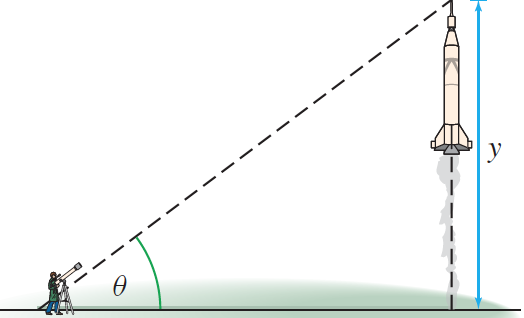Recap Video
Take a look at the following video which recaps the ideas from the section.
_
Example Video
Below is a video showing a worked example.
Problems
The side of a cube is increasing at a rate of inches/second. How fast is the
volume changing at the moment the side length is inches.
Let’s draw a
picture.  Let’s call the length of one side . To say that the side of the cube is increasing
at a rate of inches/second means that
Note that since is increasing. We are looking for the rate of change of the
volume. If the volume is , this means we are looking for . We know the
relationship between and for a cube, namely
Since and are functions of , this could be written more suggestively as . We
can differentiate both sides with respect to , noting that we have to use chain
rule on the right side. Doing this gives
We know , and the question is asking for the rate of change of the volume
when . Plugging these in gives
The units are inches/secondinches/secondinchesinches/second
.
Let’s call the length of one side . To say that the side of the cube is increasing
at a rate of inches/second means that
Note that since is increasing. We are looking for the rate of change of the
volume. If the volume is , this means we are looking for . We know the
relationship between and for a cube, namely
Since and are functions of , this could be written more suggestively as . We
can differentiate both sides with respect to , noting that we have to use chain
rule on the right side. Doing this gives
We know , and the question is asking for the rate of change of the volume
when . Plugging these in gives
The units are inches/secondinches/secondinchesinches/second
.

In the same situation as the previous problem, at what rate is the surface
area of the cube changing at the moment the side length is inches? inches/secondinches/secondinchesinches/second
.
You are standing 7 miles away from a rocket launchpad and are watching
with a telescope. A rocket takes off and rises you watch the rocket through
your telescope. At a certain moment, the rocket is rising at a rate of 5
miles/min and the angle between the telescope and the ground is . At what
rate is the angle between the telescope and the ground changing at this
moment?
Here is a picture to model the situation, taken from Rogawski’s
“Calculus”:  If the rocket’s height is , then the rocket’s velocity is
We know the distance between the telescope and the launchpad is miles.
Which trig function relates this side, , and ?
If the rocket’s height is , then the rocket’s velocity is
We know the distance between the telescope and the launchpad is miles.
Which trig function relates this side, , and ?

sine cosine tangent
Therefore, we can say . The question is asking for . Differentiating both sides
of the above relation with respect to gives
We know . We are looking for at the moment . We know
Plugging this into the above relation gives
Therefore,
In the above problem, at what rate is the distance between the rocket
and the telescope changing at the moment the rocket’s velocity is
miles/min and the angle between the telescope and the ground is ?
miles/min.